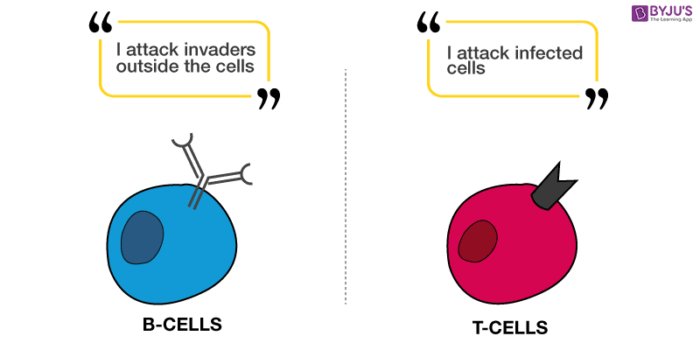Easy Images of 3 Types of Lymphocytes
Lymphocytes are a type of white blood cells present in the blood and lymph of our body. The main function of lymphocytes is to produce antibodies and protect against viruses, bacteria and toxins. These lymphocytes can be classified into B lymphocytes, T lymphocytes and natural killer cells. Here, let's discuss the structure and functions of these lymphocytes.
Table of Content
- Lymphocytes – Meaning and Definition
- Lymphocytes Types
- B Lymphocytes
- T Lymphocytes
- Natural Killer Cells
- Lymphocytes Function
- Frequently Asked Questions
Lymphocytes – Meaning and Definition
Lymphocytes are a type of white blood cells present in the blood and lymph of our body. They are responsible for adaptive or acquired immunity. They are a type of agranulocytes. Around 20-25% of white blood cells are B and T lymphocytes. 99% of the cells of lymph are lymphocytes.
There are three types of lymphocytes, i.e. B-lymphocytes, T-lymphocytes and Natural killer cells (NK cells). They differ in their structure and function. There are surface proteins present, which differentiate the different subtypes of lymphocytes. They are known as the cluster of differentiation or CD markers.
Lymphocytes are concentrated in the lymphoid organs, e.g. spleen, lymph nodes, tonsils, etc. and initiate the immune response against the foreign pathogen.
All the lymphocytes are produced from the stem cell in the bone marrow and later mature and differentiate in the specific organs. B- lymphocytes mature in the bone marrow, whereas T-lymphocytes mature in the thymus. B and T lymphocytes later differentiate into effector and memory cells on exposure to antigens.
Lymphocytes are responsible for both humoral (antibody-mediated) and the cell-mediated immune (CMI) response by B and T lymphocytes, respectively.
Lymphocytes Types
On the basis of structure and function, lymphocytes are divided into three main types:
- B Cells
- T Cells
- Natural Killer (NK) Cells
Let's learn more in detail about each of these lymphocytes.
B Lymphocytes
B cells get their name from the site of maturation in the birds, where they were first discovered, i.e. bursa of Fabricius. In humans and some other mammals, the main site of B lymphocytes maturation is the bone marrow.
The mature B cell synthesizes and expresses the specific antibodies produced in response to the antigen. It binds to the specific antigen by the membrane-bound immunoglobulin or antibody, which is also known as BCR or B-cell receptor.
The activated B cells further differentiate into plasma cells or effector cells. They lose the surface antibody and start producing the specific antibodies in a large amount to fight the infection.
B lymphocytes produce antibodies, hence they are known to trigger the humoral immune response.
Memory B cells are formed after primary infection and they remain in the blood for decades. They circulate in the blood, identify and act against previously infected antigens.
T Lymphocytes
T cells also get their name from the site of maturation, i.e. thymus. T cells also have surface receptors to recognize antigens but they do not directly bind to the antigens like surface antibody receptors on B cells.
T cell receptors recognize antigens bound to a special kind of cell membrane protein known as major histocompatibility complex or MHC molecules.
T lymphocytes differentiate into two main subtypes:
- T helper (TH) cells- They generally contain CD4 membrane glycoprotein on their surface and recognise antigens with class II MHC.
The major function of T helper cells is to trigger different types of immune cells to act against the antigens like macrophages, B lymphocytes and cytotoxic T cells. The effector T cells secrete different types of cytokines, which directs the immune response by other cell types.
- T cytotoxic (TC) cells- They generally contain CD8 membrane glycoprotein on their surface and recognise antigens with class I MHC.
After activation, they proliferate and differentiate into cytotoxic T lymphocytes. It eliminates virus-infected cells, tumour or cancerous cells and also foreign grafts, etc.
Another type of T cells known as the regulatory T cell, functions as the regulators of immune responses.
The memory T cells are antigen-specific T cells which have a longer life span. They play a key role in rapid immune response on the re-exposure of an infectious agent. They are responsible for the secondary response.

Natural Killer Cells
Natural killer or NK cells are a part of innate immunity and they do not have antigen-specific receptors present on the surface. They play a major role in eliminating tumour cells and infected cells. They distinguish the normal cells from the infected or cancerous cells by MHC class I surface molecules, which is absent in most of the abnormal cells.
NK cells are also activated by cytokines known as interferons. Activated natural killer cells release cytotoxic granules, which kill infected cells.
Lymphocytes Function
Lymphocytes play a major role in adaptive immunity. The B cells are responsible for humoral immunity and T cells are required for the cell-mediated immunity. The B cells secrete antibodies, which are transported by blood hence they can work over a long distance, whereas T cells can migrate to the target tissues and act locally.
The acquired immune response is specific to the pathogen. Once acquired, it is stored in the memory cell, so that when the infection is repeated, it triggers a highly amplified secondary response.
Also see: Important Notes- Human Health and Disease
The normal lymphocyte count is 1000 to 4800 per µl. An increase or decrease in the lymphocyte count has a clinical significance. The increase in lymphocyte count is known as lymphocytosis. It is an indication of viral infection and also can be due to leukaemia. The decrease in the lymphocyte count from the normal range is known as lymphocytopenia. It is associated with immune deficiency diseases, malnutrition and certain inherited disorders, etc.
This was all about Lymphocytes. For more such topics related to NEET, visit BYJU'S. Check NEET Biology Flashcards for the revision of important concepts.
Recommended Video:
Body Fluids and Circulation

Also Read:
- How does Interphase prepare a cell to divide?
- Short Notes on Disorders of Joints
- Euglena Structure and Classification
Frequently Asked Questions
What are lymphocytes?
It is a type of leukocyte present in the immune system of most vertebrates. These cells are concentrated in the lymphoid organs, e.g. spleen, lymph nodes, tonsils, etc.
What are the functions of lymphocytes?
Lymphocytes play a major role in adaptive immunity. The B lymphocytes are responsible for humoral immunity and T lymphocytes are required for cell-mediated immunity. The natural killer cell functions in cytotoxic innate and cell-mediated immunity.
What does it mean when your lymphocytes are high?
The condition of having a high lymphocyte count is known as lymphocytosis. It primarily indicates that our body is fighting with an infection. On a deeper level, it can indicate some serious conditions like leukaemia.
What does it mean when lymphocytes are low?
The condition of having a low lymphocyte count is called lymphocytopenia. It makes it difficult for the body to fight infections.
What is a normal lymphocyte count?
Normal lymphocyte count for adults is between 1100 to 4800 cells per microlitre of blood. For children the normal lymphocyte count ranges between 3000 to 9500 cells per microlitre of blood.
Source: https://byjus.com/neet/lymphocytes/
0 Response to "Easy Images of 3 Types of Lymphocytes"
Post a Comment